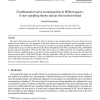CORR
2012
Springer
13 years 2 months ago
2012
Springer
Let G be a directed graph with n vertices and non-negative weights in its directed edges, embedded on a surface of genus g, and let f be an arbitrary face of G. We describe an alg...
COMGEO
2002
ACM
14 years 6 months ago
2002
ACM
The goals of this paper are twofold. The first is to present a new sampling theory for curves, based on a new notion of local feature size. The properties of this new feature size...
SODA
2010
ACM
15 years 4 months ago
2010
ACM
We introduce the problem of shape replication in the Wang tile self-assembly model. Given an input shape, we consider the problem of designing a self-assembly system which will re...
SODA
2010
ACM
15 years 4 months ago
2010
ACM
The class of constraint satisfactions problems (CSPs) captures many fundamental combinatorial optimization problems such as Max Cut, Max q-Cut, Unique Games, and Max k-Sat. Recent...
SODA
2010
ACM
15 years 4 months ago
2010
ACM
SODA
2010
ACM
15 years 4 months ago
2010
ACM
We consider robust network design problems where the set of feasible demands may be given by an arbitrary polytope or convex body more generally. This model, introduced by BenAmeu...
SODA
2010
ACM
15 years 4 months ago
2010
ACM
We describe an algorithm for computing planar convex hulls in the self-improving model: given a sequence I1, I2, . . . of planar n-point sets, the upper convex hull conv(I) of eac...
SODA
2010
ACM
15 years 4 months ago
2010
ACM
The quadratic assignment problem (QAP) is a central problem in combinatorial optimization. Several famous computationally hard tasks, such as graph matching, partitioning, and the...
SODA
2010
ACM
15 years 4 months ago
2010
ACM
We consider the problem of reconstructing a road network from a collection of path traces and provide guarantees on the accuracy of the reconstruction under reasonable assumptions...
SODA
2010
ACM
15 years 4 months ago
2010
ACM
This paper analyzes the complexity of problems from class field theory. Class field theory can be used to show the existence of infinite families of number fields with constant ro...

